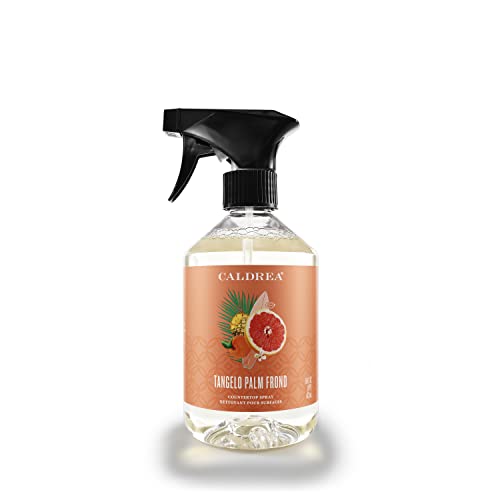
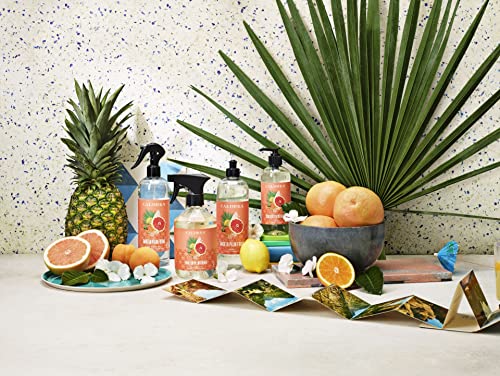
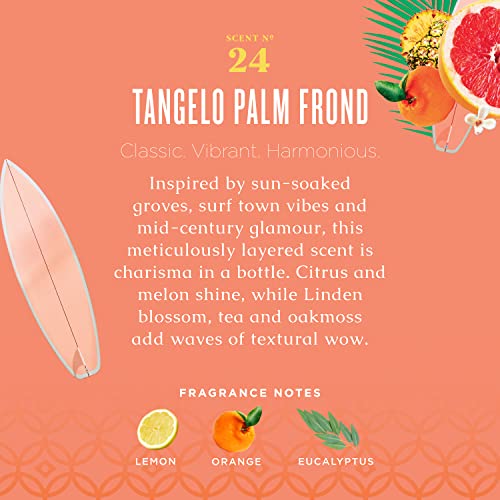
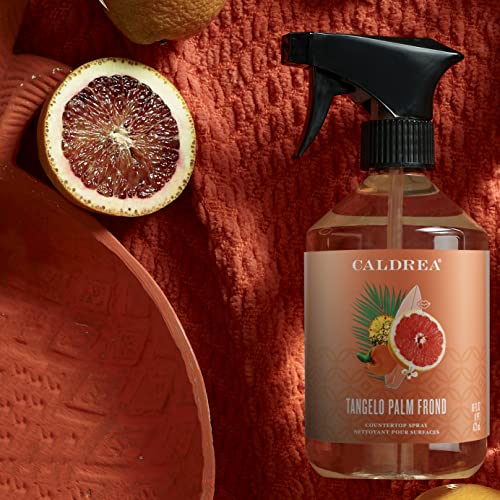
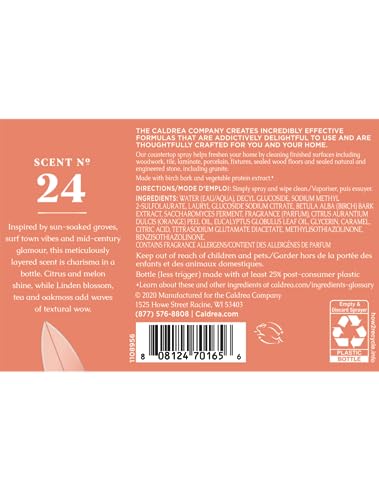
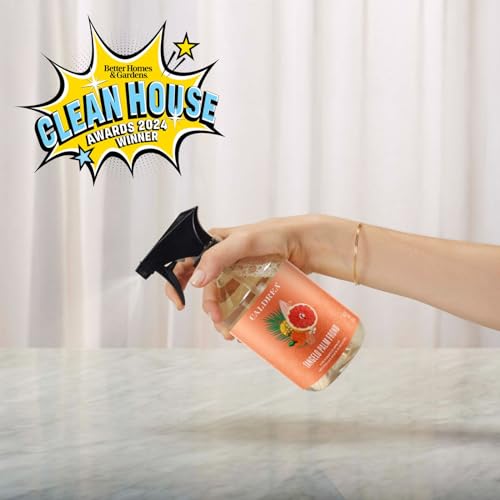
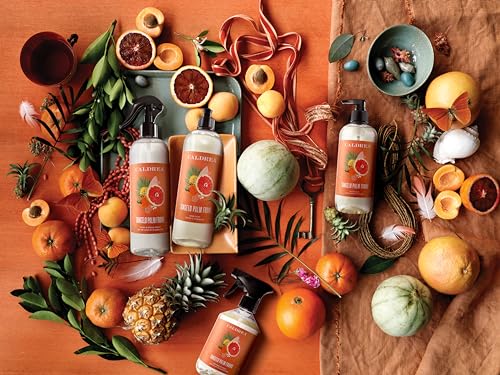
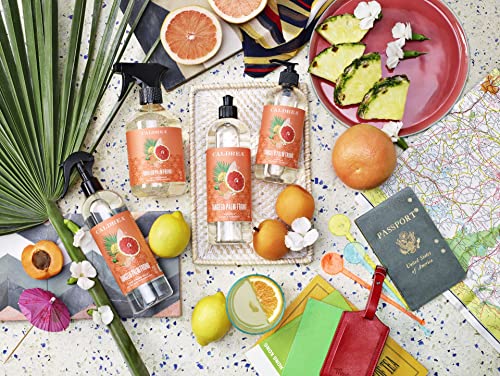
Caldrea Multi-Surface Cleaner - Odor Eliminator with Tangelo Palm Frond Scent - 16oz


Benzisothiazolinone
High RiskBenzisothiazolinone is a heterocyclic compound commonly used as a preservative in various products due to its effectiveness in preventing microbial growth. It is often found in paints, coatings, and personal care items.
Sustai Insights
Benzisothiazolinone serves effectively as a preservative, inhibiting bacterial and fungal growth, which prolongs product shelf life. However, it is associated with moderate allergenic potential and has high use restrictions due to regulatory concerns. Environmental risks include its classification as a pollutant, with potential bioaccumulation. Regulatory bodies have flagged it for unacceptable use levels in verified products, leading to an overall high-risk assessment. Safe usage practices are essential, and alternatives such as natural preservatives may be considered.
Fragrance
High RiskFragrance refers to a mixture of aromatic compounds used in products to provide scent. It is commonly listed as 'fragrance' or 'parfum' on product labels and can serve various functions, including enhancing user experience and masking undesirable odors.
Sustai Insights
Fragrance offers functional benefits by improving product appeal; however, it poses significant health risks, notably a high likelihood of causing allergies and allergic contact dermatitis. Environmental risks include potential pollution and endocrine disruption, though its overall carcinogenicity is low. Regulatory bodies have noted concerns regarding its use, leading to a high-risk classification. Safe usage practices should be observed, and alternatives such as natural essential oils are recommended for those sensitive to synthetic fragrances.
Methylisothiazolinone
High RiskMethylisothiazolinone is a widely-used preservative in cosmetic and personal care products, known for its antimicrobial properties. It helps prevent the growth of bacteria and fungi, extending the shelf life of formulations. It is often used in leave-on and rinse-off products, including lotions and shampoos.
Sustai Insights
Methylisothiazolinone serves as an effective preservative, combating microbial growth in various personal care items. However, it is associated with a high risk of allergic reactions and skin sensitization, especially in individuals exposed repeatedly. Regulatory bodies have imposed use restrictions due to these health concerns. Additionally, while it is not considered a carcinogen, its environmental impact includes potential pollutant characteristics. Overall, the risk associated with methylisothiazolinone is high, prompting caution and consideration of safer alternatives.
Citric Acid
Medium RiskCitric acid is an alpha hydroxy acid used in personal care products primarily for its role as a pH adjuster and natural preservative. It occurs naturally in citrus fruits and is commonly utilized in various formulations for its chelating properties and mild exfoliation benefits.
Sustai Insights
Citric acid offers functional benefits as an effective preservative and pH stabilizer, contributing to product longevity and stability. It is biodegradable and derived from renewable sources. Health risks are low, with minimal concerns regarding carcinogenicity, allergies, and reproductive toxicity. However, moderate use restrictions exist due to potential irritation at high concentrations. Environmental risks are limited, as citric acid is not known to accumulate in ecosystems. Regulatory agencies have no significant advisories against its use. Overall, it is assessed as a medium-risk ingredient, with safe usage practices recommended and alternatives available.
Citrus Aurantium Dulcis (Orange) Peel Oil
Medium RiskCitrus aurantium dulcis (orange) peel oil is derived from the peel of oranges and is commonly used in cosmetic and personal care products for its fragrance and potential skin benefits. It is known for its aromatic properties and is often included in formulations aimed at enhancing scent profiles.
Sustai Insights
Citrus aurantium dulcis (orange) peel oil offers functional benefits such as providing a pleasant scent and potential antimicrobial properties. However, it poses a high allergy risk and may cause skin irritation in sensitive individuals. Environmental concerns include moderate persistence and potential to contribute to pollution. Regulatory warnings indicate restrictions on use in certain products. Overall, the risk level is assessed as medium, and users are advised to practice caution, particularly those with known allergies. Alternatives like sweet orange essential oil may provide similar benefits with potentially lower risks.
Eucalyptus Globulus (Eucalyptus) Leaf Oil
Medium RiskEucalyptus globulus leaf oil is a volatile oil derived from the leaves of the eucalyptus tree, primarily used for its aromatic properties and as a potential antimicrobial agent in various products.
Sustai Insights
Eucalyptus globulus leaf oil offers functional benefits like fragrance and potential antimicrobial properties, supporting product efficacy. However, it presents high allergenic potential and moderate irritation concerns, which may pose health risks. Environmental risks include possible pollution and bioaccumulation. Regulatory restrictions are in place regarding its use in certain products. Overall, the risk level is medium, necessitating caution in usage and consideration of alternatives like tea tree oil or peppermint oil.
Tetrasodium Glutamate Diacetate
Low RiskTetrasodium glutamate diacetate is a sodium salt of glutamic acid, primarily functioning as a chelating agent in various cosmetic and personal care products. It helps stabilize formulations by binding metal ions, thereby enhancing product efficacy and shelf life.
Sustai Insights
Tetrasodium glutamate diacetate is recognized for its functional benefits in stabilizing formulations and preventing metal ion interference. It poses low health risks, with minimal concerns regarding carcinogenicity, allergies, or reproductive toxicity. Environmental impacts are also low, with no significant pollutant or bioaccumulation concerns noted. Regulatory bodies do not impose severe restrictions on its use. Overall, it is considered a low-risk ingredient. Safe usage practices should be followed, and alternatives such as other chelating agents may be explored for specific formulations.
Decyl Glucoside
Low RiskDecyl glucoside is a glucose-based surfactant derived from natural sources, primarily used as a mild cleansing agent in personal care products. It effectively reduces surface tension, allowing for improved mixing of ingredients and enhanced cleansing properties without stripping natural oils from the skin.
Sustai Insights
Decyl glucoside offers functional benefits as a non-ionic surfactant, making it suitable for sensitive skin formulations. It is biodegradable and derived from renewable resources, supporting sustainability. Health risks are primarily low, with minimal concerns regarding irritation and allergies. Environmental risks are low, as it does not significantly contribute to pollution or bioaccumulation. Regulatory status is generally favorable, with low restrictions noted. Overall, decyl glucoside presents a low risk for use in consumer products, making it a suitable choice for gentle formulations.
Sodium Methyl 2 Sulfolaurate
Low RiskSodium methyl 2 sulfolaurate is a surfactant primarily used in personal care and cleaning products. It functions to reduce surface tension, enabling better spreading and cleaning properties. This ingredient is typically derived from renewable resources and is noted for its mild nature in formulations.
Sustai Insights
Sodium methyl 2 sulfolaurate offers functional benefits as an effective surfactant, contributing to the cleaning efficacy of products while being derived from renewable sources, which supports sustainability. Health risks are considered low, with no significant concerns regarding carcinogenicity, allergies, or reproductive toxicity. Environmental risks are also low, as it does not bioaccumulate or contribute significantly to pollution. Regulatory bodies do not impose restrictions on its use. Overall, this ingredient presents a low-risk profile, with no notable adverse effects, making it a viable option in formulations.
Sodium Citrate
Low RiskSodium citrate is used in cosmetic formulations primarily as a buffering agent, helping to stabilize pH levels. It is derived from citric acid and is commonly found in various personal care products to enhance their efficacy and stability.
Sustai Insights
Sodium citrate offers functional benefits such as effective pH regulation and acts as a mild preservative. It is generally recognized as safe with low risks for cancer, allergies, and reproductive toxicity. Environmental concerns are minimal, with no significant pollutant potential or bioaccumulation. Regulatory bodies like the FDA and COSMOS have no major restrictions on its use. Overall, sodium citrate presents a low risk, making it a viable ingredient in cosmetic formulations. Safe usage practices should be followed, and alternatives are not typically necessary.
Vegetarian Glycerin
Low RiskVegetarian glycerin, also known as glycerol, is a colorless, odorless, and viscous liquid derived from plant sources. It is primarily used as a humectant, solvent, and emollient in various personal care products, helping to retain moisture and improve texture.
Sustai Insights
Vegetarian glycerin offers functional benefits as an effective humectant, promoting hydration and skin smoothness. It is biodegradable and typically sustainably sourced. Health risks associated with glycerin are low, with no significant concerns for carcinogenicity, allergens, or reproductive toxicity. Environmental risks are minimal, and it is not subject to major regulatory warnings. Overall, the risk level for this ingredient is low, making it a safe choice in formulations. Safe usage practices include ensuring proper concentrations in products, and alternatives such as propylene glycol exist but may have differing properties.
Betula Pubescens (White Birch) Bark Extract
Low RiskBetula pubescens (white birch) bark extract is derived from the bark of the Betula pubescens tree. It is typically obtained through ethanol extraction, resulting in a concentrated form that retains the natural properties of the bark. This extract is commonly used in cosmetic formulations for its potential skin benefits.
Sustai Insights
Betula pubescens bark extract offers functional benefits such as skin conditioning and potential anti-inflammatory properties. It is sustainably sourced, with low risks for carcinogenicity, allergies, and reproductive toxicity. Environmental concerns are minimal, as it does not significantly contribute to pollution or bioaccumulation. Regulatory status is favorable, with no current restrictions. Overall, the risk level associated with this ingredient is low, making it a suitable choice in formulations, though users should adhere to safe usage practices.
Saccharomyces/ Ferment
Low RiskSaccharomyces ferment is a product obtained by fermenting Saccharomyces yeast. It is primarily used in cosmetic formulations for its potential skin conditioning and moisturizing properties. This ingredient is derived from natural sources and is often included in products aimed at improving skin texture and hydration.
Sustai Insights
Saccharomyces ferment offers functional benefits such as skin conditioning and moisture retention, making it valuable in cosmetic formulations. It is sustainably sourced and generally considered safe, with low health risks for carcinogenicity, allergens, and reproductive toxicity. Environmental concerns are minimal, with no significant pollutants or bioaccumulation. Regulatory bodies have not issued warnings against its use. Overall, the ingredient poses low risk, and no specific usage restrictions have been identified, making it a suitable choice in cosmetic products.
Betula Alba (Birch)
Low RiskBetula alba, commonly known as birch, is a deciduous tree species recognized for its distinctive bark and leaves. In cosmetic and personal care products, it is often utilized for its potential soothing and anti-inflammatory properties, serving various functions such as an emollient or skin conditioner.
Sustai Insights
Betula alba offers functional benefits like skin soothing and hydration, contributing to product efficacy. It is generally considered to have low health risks, with no significant concerns regarding carcinogenicity, allergies, or reproductive toxicity. Environmentally, birch is not associated with pollution or bioaccumulation. Regulatory assessments indicate no current restrictions. Overall, the ingredient presents a low risk profile. For those seeking alternatives, other plant-based extracts may provide similar benefits.
Water
Low RiskWater is a clear, colorless liquid essential for various biological processes. It serves as a solvent in formulations, facilitating the dissolution of other ingredients and enhancing product texture and application. Additionally, water plays a crucial role in hydration and is a key component in many cosmetic and personal care products.
Sustai Insights
Water is an effective solvent and hydrator, contributing to the texture and efficacy of formulations. It is biodegradable and generally regarded as safe, with low concerns regarding carcinogenicity, allergies, and reproductive toxicity. However, excessive water usage can lead to environmental concerns, particularly regarding resource depletion. Regulatory bodies do not impose restrictions on water use in cosmetics. Overall, the risks associated with water are low, making it a safe and essential ingredient.
Caramel Color
Low RiskCaramel color is a concentrated sugary material obtained through the controlled heat treatment of carbohydrates, primarily used as a food coloring agent. It is commonly incorporated in various food and beverage products to impart a brown hue and enhance visual appeal.
Sustai Insights
Caramel color serves effectively as a coloring agent in food products, contributing to aesthetic appeal without substantial health risks. Regulatory assessments indicate low concerns regarding carcinogenicity, allergenic potential, and reproductive toxicity. However, contamination during production may pose risks. While it is generally recognized as safe, its environmental impact is minimal, leading to an overall low-risk assessment. Safe usage practices are advised, and alternatives like natural colorants exist for those seeking eco-friendlier options.
Disodium 2 Sulfolaurate
Low RiskDisodium 2 sulfolaurate is a surfactant and emulsifying agent commonly used in personal care products. It functions primarily to help cleanse, foaming, and stabilize formulations, enhancing the overall texture and performance of the product.
Sustai Insights
Disodium 2 sulfolaurate offers functional benefits as an effective surfactant, improving product stability and user experience. It is considered to have low health risks, with no significant concerns regarding carcinogenicity, allergenic potential, or reproductive toxicity. Environmental risks are minimal, with no evidence of bioaccumulation or significant pollution. Regulatory assessments indicate no current restrictions, affirming its safe use. Overall, the risk level is low, making it a suitable ingredient in formulated products.
Tetrasodium Glutamate Diacetate
Low RiskTetrasodium glutamate diacetate is a sodium salt of glutamic acid, primarily functioning as a chelating agent in various cosmetic and personal care products. It helps stabilize formulations by binding metal ions, thereby enhancing product efficacy and shelf life.
Sustai Insights
Tetrasodium glutamate diacetate is recognized for its functional benefits in stabilizing formulations and preventing metal ion interference. It poses low health risks, with minimal concerns regarding carcinogenicity, allergies, or reproductive toxicity. Environmental impacts are also low, with no significant pollutant or bioaccumulation concerns noted. Regulatory bodies do not impose severe restrictions on its use. Overall, it is considered a low-risk ingredient. Safe usage practices should be followed, and alternatives such as other chelating agents may be explored for specific formulations.
Decyl Glucoside
Low RiskDecyl glucoside is a glucose-based surfactant derived from natural sources, primarily used as a mild cleansing agent in personal care products. It effectively reduces surface tension, allowing for improved mixing of ingredients and enhanced cleansing properties without stripping natural oils from the skin.
Sustai Insights
Decyl glucoside offers functional benefits as a non-ionic surfactant, making it suitable for sensitive skin formulations. It is biodegradable and derived from renewable resources, supporting sustainability. Health risks are primarily low, with minimal concerns regarding irritation and allergies. Environmental risks are low, as it does not significantly contribute to pollution or bioaccumulation. Regulatory status is generally favorable, with low restrictions noted. Overall, decyl glucoside presents a low risk for use in consumer products, making it a suitable choice for gentle formulations.
Sodium Methyl 2 Sulfolaurate
Low RiskSodium methyl 2 sulfolaurate is a surfactant primarily used in personal care and cleaning products. It functions to reduce surface tension, enabling better spreading and cleaning properties. This ingredient is typically derived from renewable resources and is noted for its mild nature in formulations.
Sustai Insights
Sodium methyl 2 sulfolaurate offers functional benefits as an effective surfactant, contributing to the cleaning efficacy of products while being derived from renewable sources, which supports sustainability. Health risks are considered low, with no significant concerns regarding carcinogenicity, allergies, or reproductive toxicity. Environmental risks are also low, as it does not bioaccumulate or contribute significantly to pollution. Regulatory bodies do not impose restrictions on its use. Overall, this ingredient presents a low-risk profile, with no notable adverse effects, making it a viable option in formulations.
Benzisothiazolinone
High RiskBenzisothiazolinone is a heterocyclic compound commonly used as a preservative in various products due to its effectiveness in preventing microbial growth. It is often found in paints, coatings, and personal care items.
Sustai Insights
Benzisothiazolinone serves effectively as a preservative, inhibiting bacterial and fungal growth, which prolongs product shelf life. However, it is associated with moderate allergenic potential and has high use restrictions due to regulatory concerns. Environmental risks include its classification as a pollutant, with potential bioaccumulation. Regulatory bodies have flagged it for unacceptable use levels in verified products, leading to an overall high-risk assessment. Safe usage practices are essential, and alternatives such as natural preservatives may be considered.
Citric Acid
Medium RiskCitric acid is an alpha hydroxy acid used in personal care products primarily for its role as a pH adjuster and natural preservative. It occurs naturally in citrus fruits and is commonly utilized in various formulations for its chelating properties and mild exfoliation benefits.
Sustai Insights
Citric acid offers functional benefits as an effective preservative and pH stabilizer, contributing to product longevity and stability. It is biodegradable and derived from renewable sources. Health risks are low, with minimal concerns regarding carcinogenicity, allergies, and reproductive toxicity. However, moderate use restrictions exist due to potential irritation at high concentrations. Environmental risks are limited, as citric acid is not known to accumulate in ecosystems. Regulatory agencies have no significant advisories against its use. Overall, it is assessed as a medium-risk ingredient, with safe usage practices recommended and alternatives available.
Sodium Citrate
Low RiskSodium citrate is used in cosmetic formulations primarily as a buffering agent, helping to stabilize pH levels. It is derived from citric acid and is commonly found in various personal care products to enhance their efficacy and stability.
Sustai Insights
Sodium citrate offers functional benefits such as effective pH regulation and acts as a mild preservative. It is generally recognized as safe with low risks for cancer, allergies, and reproductive toxicity. Environmental concerns are minimal, with no significant pollutant potential or bioaccumulation. Regulatory bodies like the FDA and COSMOS have no major restrictions on its use. Overall, sodium citrate presents a low risk, making it a viable ingredient in cosmetic formulations. Safe usage practices should be followed, and alternatives are not typically necessary.
Vegetarian Glycerin
Low RiskVegetarian glycerin, also known as glycerol, is a colorless, odorless, and viscous liquid derived from plant sources. It is primarily used as a humectant, solvent, and emollient in various personal care products, helping to retain moisture and improve texture.
Sustai Insights
Vegetarian glycerin offers functional benefits as an effective humectant, promoting hydration and skin smoothness. It is biodegradable and typically sustainably sourced. Health risks associated with glycerin are low, with no significant concerns for carcinogenicity, allergens, or reproductive toxicity. Environmental risks are minimal, and it is not subject to major regulatory warnings. Overall, the risk level for this ingredient is low, making it a safe choice in formulations. Safe usage practices include ensuring proper concentrations in products, and alternatives such as propylene glycol exist but may have differing properties.
Betula Pubescens (White Birch) Bark Extract
Low RiskBetula pubescens (white birch) bark extract is derived from the bark of the Betula pubescens tree. It is typically obtained through ethanol extraction, resulting in a concentrated form that retains the natural properties of the bark. This extract is commonly used in cosmetic formulations for its potential skin benefits.
Sustai Insights
Betula pubescens bark extract offers functional benefits such as skin conditioning and potential anti-inflammatory properties. It is sustainably sourced, with low risks for carcinogenicity, allergies, and reproductive toxicity. Environmental concerns are minimal, as it does not significantly contribute to pollution or bioaccumulation. Regulatory status is favorable, with no current restrictions. Overall, the risk level associated with this ingredient is low, making it a suitable choice in formulations, though users should adhere to safe usage practices.
Saccharomyces/ Ferment
Low RiskSaccharomyces ferment is a product obtained by fermenting Saccharomyces yeast. It is primarily used in cosmetic formulations for its potential skin conditioning and moisturizing properties. This ingredient is derived from natural sources and is often included in products aimed at improving skin texture and hydration.
Sustai Insights
Saccharomyces ferment offers functional benefits such as skin conditioning and moisture retention, making it valuable in cosmetic formulations. It is sustainably sourced and generally considered safe, with low health risks for carcinogenicity, allergens, and reproductive toxicity. Environmental concerns are minimal, with no significant pollutants or bioaccumulation. Regulatory bodies have not issued warnings against its use. Overall, the ingredient poses low risk, and no specific usage restrictions have been identified, making it a suitable choice in cosmetic products.
Citrus Aurantium Dulcis (Orange) Peel Oil
Medium RiskCitrus aurantium dulcis (orange) peel oil is derived from the peel of oranges and is commonly used in cosmetic and personal care products for its fragrance and potential skin benefits. It is known for its aromatic properties and is often included in formulations aimed at enhancing scent profiles.
Sustai Insights
Citrus aurantium dulcis (orange) peel oil offers functional benefits such as providing a pleasant scent and potential antimicrobial properties. However, it poses a high allergy risk and may cause skin irritation in sensitive individuals. Environmental concerns include moderate persistence and potential to contribute to pollution. Regulatory warnings indicate restrictions on use in certain products. Overall, the risk level is assessed as medium, and users are advised to practice caution, particularly those with known allergies. Alternatives like sweet orange essential oil may provide similar benefits with potentially lower risks.
Eucalyptus Globulus (Eucalyptus) Leaf Oil
Medium RiskEucalyptus globulus leaf oil is a volatile oil derived from the leaves of the eucalyptus tree, primarily used for its aromatic properties and as a potential antimicrobial agent in various products.
Sustai Insights
Eucalyptus globulus leaf oil offers functional benefits like fragrance and potential antimicrobial properties, supporting product efficacy. However, it presents high allergenic potential and moderate irritation concerns, which may pose health risks. Environmental risks include possible pollution and bioaccumulation. Regulatory restrictions are in place regarding its use in certain products. Overall, the risk level is medium, necessitating caution in usage and consideration of alternatives like tea tree oil or peppermint oil.
Betula Alba (Birch)
Low RiskBetula alba, commonly known as birch, is a deciduous tree species recognized for its distinctive bark and leaves. In cosmetic and personal care products, it is often utilized for its potential soothing and anti-inflammatory properties, serving various functions such as an emollient or skin conditioner.
Sustai Insights
Betula alba offers functional benefits like skin soothing and hydration, contributing to product efficacy. It is generally considered to have low health risks, with no significant concerns regarding carcinogenicity, allergies, or reproductive toxicity. Environmentally, birch is not associated with pollution or bioaccumulation. Regulatory assessments indicate no current restrictions. Overall, the ingredient presents a low risk profile. For those seeking alternatives, other plant-based extracts may provide similar benefits.
Water
Low RiskWater is a clear, colorless liquid essential for various biological processes. It serves as a solvent in formulations, facilitating the dissolution of other ingredients and enhancing product texture and application. Additionally, water plays a crucial role in hydration and is a key component in many cosmetic and personal care products.
Sustai Insights
Water is an effective solvent and hydrator, contributing to the texture and efficacy of formulations. It is biodegradable and generally regarded as safe, with low concerns regarding carcinogenicity, allergies, and reproductive toxicity. However, excessive water usage can lead to environmental concerns, particularly regarding resource depletion. Regulatory bodies do not impose restrictions on water use in cosmetics. Overall, the risks associated with water are low, making it a safe and essential ingredient.
Fragrance
High RiskFragrance refers to a mixture of aromatic compounds used in products to provide scent. It is commonly listed as 'fragrance' or 'parfum' on product labels and can serve various functions, including enhancing user experience and masking undesirable odors.
Sustai Insights
Fragrance offers functional benefits by improving product appeal; however, it poses significant health risks, notably a high likelihood of causing allergies and allergic contact dermatitis. Environmental risks include potential pollution and endocrine disruption, though its overall carcinogenicity is low. Regulatory bodies have noted concerns regarding its use, leading to a high-risk classification. Safe usage practices should be observed, and alternatives such as natural essential oils are recommended for those sensitive to synthetic fragrances.
Methylisothiazolinone
High RiskMethylisothiazolinone is a widely-used preservative in cosmetic and personal care products, known for its antimicrobial properties. It helps prevent the growth of bacteria and fungi, extending the shelf life of formulations. It is often used in leave-on and rinse-off products, including lotions and shampoos.
Sustai Insights
Methylisothiazolinone serves as an effective preservative, combating microbial growth in various personal care items. However, it is associated with a high risk of allergic reactions and skin sensitization, especially in individuals exposed repeatedly. Regulatory bodies have imposed use restrictions due to these health concerns. Additionally, while it is not considered a carcinogen, its environmental impact includes potential pollutant characteristics. Overall, the risk associated with methylisothiazolinone is high, prompting caution and consideration of safer alternatives.
Caramel Color
Low RiskCaramel color is a concentrated sugary material obtained through the controlled heat treatment of carbohydrates, primarily used as a food coloring agent. It is commonly incorporated in various food and beverage products to impart a brown hue and enhance visual appeal.
Sustai Insights
Caramel color serves effectively as a coloring agent in food products, contributing to aesthetic appeal without substantial health risks. Regulatory assessments indicate low concerns regarding carcinogenicity, allergenic potential, and reproductive toxicity. However, contamination during production may pose risks. While it is generally recognized as safe, its environmental impact is minimal, leading to an overall low-risk assessment. Safe usage practices are advised, and alternatives like natural colorants exist for those seeking eco-friendlier options.
Disodium 2 Sulfolaurate
Low RiskDisodium 2 sulfolaurate is a surfactant and emulsifying agent commonly used in personal care products. It functions primarily to help cleanse, foaming, and stabilize formulations, enhancing the overall texture and performance of the product.
Sustai Insights
Disodium 2 sulfolaurate offers functional benefits as an effective surfactant, improving product stability and user experience. It is considered to have low health risks, with no significant concerns regarding carcinogenicity, allergenic potential, or reproductive toxicity. Environmental risks are minimal, with no evidence of bioaccumulation or significant pollution. Regulatory assessments indicate no current restrictions, affirming its safe use. Overall, the risk level is low, making it a suitable ingredient in formulated products.
Experience the refreshing essence of old Hollywood with Caldrea Multi-Surface Countertop Spray Cleaner in Tangelo Palm Frond scent. This eco-friendly cleaner effortlessly revitalizes your home while being safe for all finished surfaces.
- Effortless Cleaning: Simply spray and wipe to remove dirt and odors, making your cleaning routine quick and easy.
- Safe for All Surfaces: Works effectively on wood, tile, laminate, porcelain, and sealed natural stone, ensuring versatility in your cleaning needs.
- Natural Ingredients: Formulated with vegetable protein extract and birch bark, it provides a powerful clean without harsh chemicals.
- Invigorating Scent: Enjoy the uplifting tangelo and palm frond fragrance that refreshes both your space and your mind as you clean.
- Sustainability Focus: Committed to eco-friendly practices, Caldrea promotes health-conscious living while supporting a cleaner planet.
Subscribe & Save with Sustai
- Best Price Guarantee: Always enjoy the lowest prices on sustainable home essentials.
- No Surprises: We’ll notify you before shipping. No hidden fees, ever.
- You’re in Charge: Change, pause, or cancel your subscription anytime with ease.
- Eco-Friendly Deliveries: Our grouped shipments mean less packaging and lower emissions.
Join us on a sustainable journey. Special offers for a limited time! Prices and promotions may change.
Recommended Products
Experience the refreshing essence of old Hollywood with Caldrea Multi-Surface Countertop Spray Cleaner in Tangelo Palm Frond scent. This eco-friendly cleaner effortlessly revitalizes your home while being safe for all finished surfaces.
- Effortless Cleaning: Simply spray and wipe to remove dirt and odors, making your cleaning routine quick and easy.
- Safe for All Surfaces: Works effectively on wood, tile, laminate, porcelain, and sealed natural stone, ensuring versatility in your cleaning needs.
- Natural Ingredients: Formulated with vegetable protein extract and birch bark, it provides a powerful clean without harsh chemicals.
- Invigorating Scent: Enjoy the uplifting tangelo and palm frond fragrance that refreshes both your space and your mind as you clean.
- Sustainability Focus: Committed to eco-friendly practices, Caldrea promotes health-conscious living while supporting a cleaner planet.

You can have at most 2 Sustainable Steals products in your cart
Customer Reviews
Customers’ View
Customers appreciate the effectiveness and eco-friendly nature of the Multi-Surface Cleaner, particularly enjoying its delightful tangelo palm frond scent. Many users highlight its ability to leave surfaces sparkling clean without any residue, making it a favorite for maintaining kitchen countertops and other finished surfaces. Comments like 'it makes the entire kitchen smell lovely' reflect the positive impact of the invigorating fragrance on their cleaning routine. However, some customers express concern over its price, feeling it may not offer the best value for money. Overall, this product resonates well with environmentally conscious consumers, as it is crafted from sustainable ingredients, reinforcing a commitment to mindful cleaning.
AI-generated from the text of customer reviewsThis product has no reviews yet.




